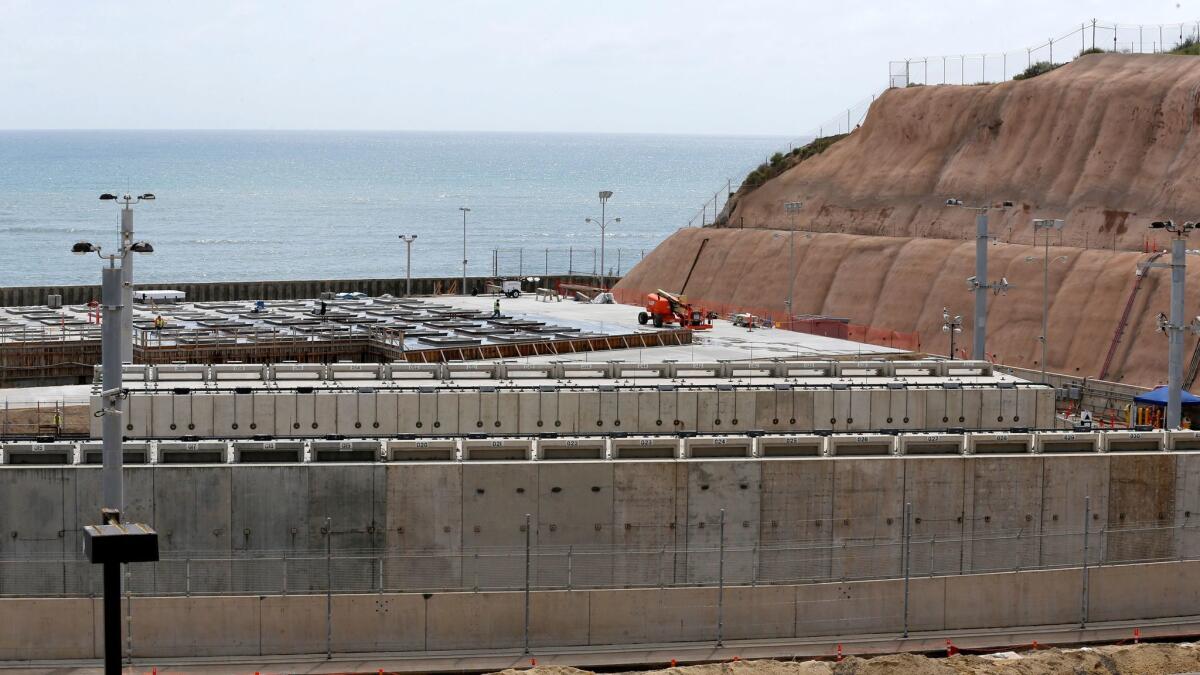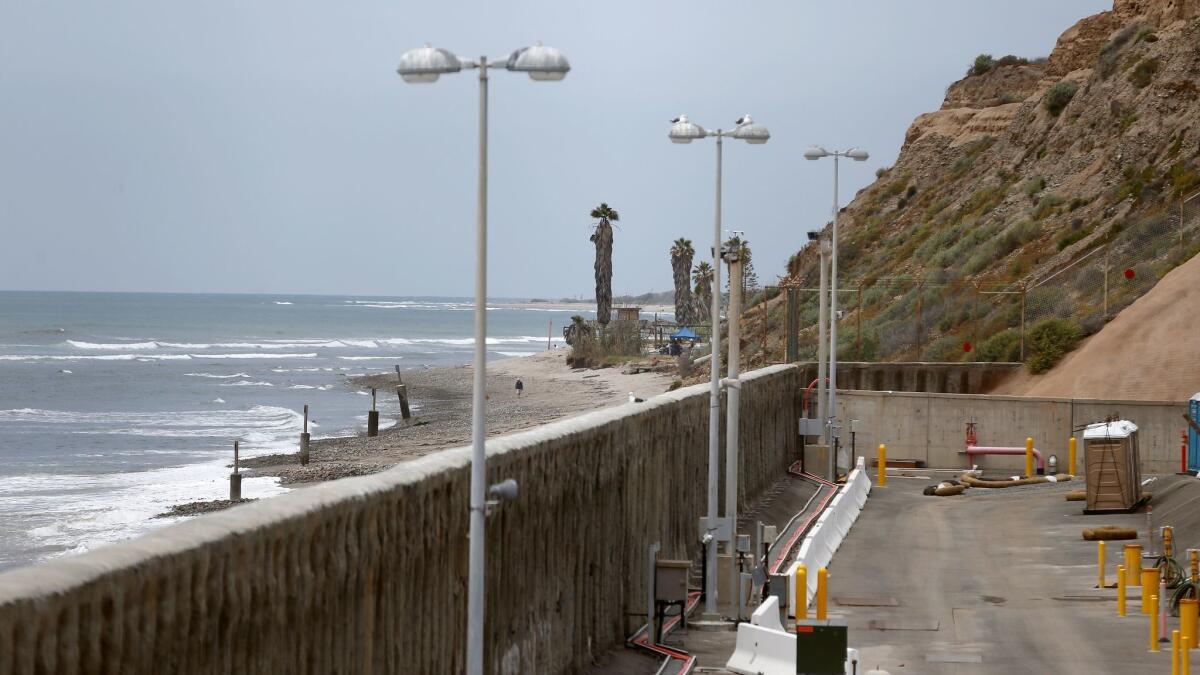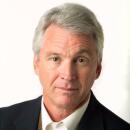Court settlement looks to move nuclear waste from San Onofre

There are 3.55 million pounds of spent fuel at the San Onofre Nuclear Generating Station (SONGS), which has not produced electricity since January 2012.
- Share via
The operators of the San Onofre Nuclear Generating Station (SONGS) promised Monday to make a good faith effort to find a location to move the 3.55 million pounds of nuclear waste that has accumulated on the plant’s premises, between the Pacific Ocean and one of the busiest freeways in the country.
Southern California Edison (SCE) made the announcement in an out-of-court settlement filed in San Diego between the utility and a pair of San Diego-area plaintiffs who sued after the California Coastal Commission in 2015 approved a 20-year permit for Edison to expand a storage system to place the plant’s spent nuclear fuel placed into heavy, dry casks.
The settlement was approved Monday by Superior Court Judge Judith Hayes.
Under the agreement, SCE commits to make “commercially reasonable” efforts to relocate the spent fuel to another facility. Among the possible sites is the Palo Verde Nuclear Generating Station in Arizona, located about 50 miles from Phoenix.
Locations in eastern New Mexico and West Texas are also mentioned.
SCE executives also committed on Monday to assemble a team of experts to develop a plan to relocate San Onofre’s spent fuel. The panel would be made up of authorities in engineering, radiation detection and nuclear waste siting and transportation.

In addition, Edison vowed to develop a more expedited inspection program for the waste at SONGS and produce a contingency plan should any of the canisters crack or leak.
“This represents the coming together of the utility, the community and a group of experts committed to moving the radioactive waste at San Onofre to a location that’s safer and more inland,” said Michael Aguirre, one of the lead attorneys for the group that took Edison to court.
SCE is required to spend $4 million in consultant fees and other costs associated with the provisions in the settlement.
In a statement, Edison president Ron Nichols said, “SCE is proud to take a leadership role in what we expect will become an industry-wide effort over many years to work with the federal government and other key stakeholders to achieve off-site storage.”
One of the plaintiffs in the case is Citizens Oversight, an East County-based civic group, that has long opposed Edison’s plans to store SONGS waste at the plant, which has not produced electricity since January 2012 and is in the process of being decommissioned.
“This (settlement) is about the best we can do and I think it’s pretty good,” said Ray Lutz, national coordinator at Citizens Oversight. “It’s a prudent step in the right direction and a step they (SCE) wouldn’t take at all if it weren’t for the lawsuit that we filed.”
The agreement sets a series of timetables for SCE to reach, both in regards to coming up with alternative locations for SONGS waste and assembling its panel of experts.
A request for proposal for qualified candidates for the panel must be delivered in 60 days and the panel must be retained — with names of the panelists made public — within 90 days of receiving the proposals.
“Now there’s a plan in place that will be implemented with progress reports,” said Maria Severson, the other lead attorney for the plaintiffs. “Experts … will get on board and report back to the public as far as moving (waste) away from” SONGS.
But while Monday’s agreement offers a possible path to move SONGS waste, significant hurdles remain.
The U.S. Nuclear Regulatory Commission, which is charged with protecting public health and safety related to nuclear energy, would have to sign off on any transfer, Aguirre said.
Plus, while the spent fuel at SONGS is the responsibility of SCE, the waste eventually must be handed over to the U.S. Department of Energy and moving any waste across state lines would assuredly involve the U.S. Department of Transportation.
Aguirre described Monday’s agreement as something that “can set a model for the rest of the nation.” Nuclear plants across the country have accumulated nearly 80,000 metric tons of spent fuel and about 2,200 tons are added each year.
The waste at SONGS has been particularly controversial.
California’s history of seismic activity unnerves many of the 8.4 million people who live within a 50-mile radius of the plant that runs right up against the Pacific on its west side and Interstate 5 to its east side.
“We’ve made the first step and we have a mechanism in place to make sure that all the other steps happen,” said Aguirre. “For the average San Diegan, before there was no hope. That sword of Damocles, the nuclear sword of Damocles, was hanging over their head indefinitely. Now there is a specific plan, a specific timeline and the authority of the court to make sure it all happens.”
Some of the waste at SONGS sits in 50 canisters that are stacked horizontally in “dry storage,” at an installation behind a seawall 28 feet high.
Another installation for the rest of the spent fuel is in the process of being constructed. The fuel now cooling in “wet storage” — in a deep pool of water — will eventually be moved to 73 thick, vertical casks.

Aguirre has called for moving SONGS waste to the Palo Verde Nuclear Generating Station in Arizona, saying it’s a logical place because Edison is a part-owner at Palo Verde, with a 15.8 percent stake.
The New Mexico and Texas sites are part of what the nuclear industry calls “consolidated interim storage,” locations where multiple nuclear plants could send their waste, provided local governments in the respective sites sign off on them.
The site in eastern New Mexico is still in the planning stages but is proposed to hold about 120,000 metric tons of waste. Representatives of the project spoke in front of a San Onofre engagement panel in May and said the plan has the support of local governments.
“One person’s waste is another person’s most valuable possession,” said John Heaton, chairman of the New Mexico group, called the Eddy-Lea Energy Alliance.
The contingent said if the project is approved, it could go online in as soon as five years — a quick turnaround when it comes to the slow pace of the bureaucracy and construction time associated with nuclear projects.
The facility in West Texas already stores low-level radioactive waste and is looking to expand. However, the company in charge, Waste Control Specialists, has run into financial difficulty. In June, the U.S. Justice Department blocked a merger the company sought to shore up its bottom line.
Potential sites in the agreement are not limited to Arizona, New Mexico and Texas.
There has been movement on Capitol Hill and by the Trump administration to bring back the Yucca Mountain nuclear waste repository in Nevada.
“Yucca as far as I’m concerned is very much an option,” Aguirre said.
Lutz said he hoped the waste could get moved out of SONGS in as little as five years but acknowledged the difficulties in reaching an agreement and opposition that would come from other states.
“People need to look at the big picture and say we need to do the right thing for everybody,” Lutz said. “This is not a ‘not in my backyard’ issue.”
Business
(619) 293-1251 Twitter: @robnikolewski
ALSO
Moving nuclear waste out of San Onofre: When and how?
Demonstrators want nuclear waste moved out of San Onofre
House panel passes bill to resurrect Yucca Mountain as site for nuclear waste
More to Read
Inside the business of entertainment
The Wide Shot brings you news, analysis and insights on everything from streaming wars to production — and what it all means for the future.
You may occasionally receive promotional content from the Los Angeles Times.











